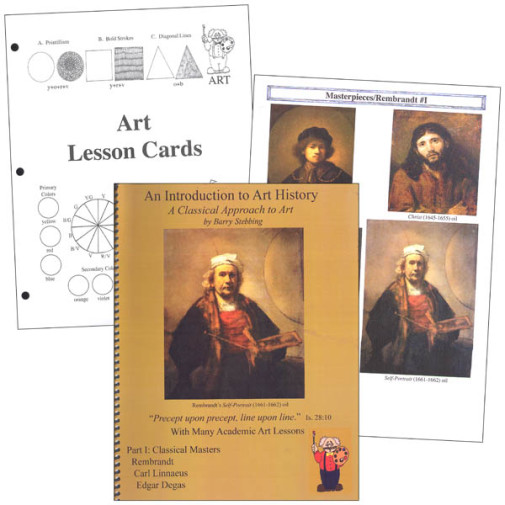We use cookies to make your experience better. To comply with the new e-Privacy directive, we need to ask for your consent to set the cookies. Learn more.
An Introduction to Art History: A Classical Approach to Art - Part I: Rembrandt, Carl Linnaeus, and Edgar Degas
Covers Impressionism and Neo Classical; primary, secondary, and tertiary colors; tones; monochromatic; color theory; foreshortening; pastels; composition; focal point; and chiaroscuro. Skills include drawing with lines, adding texture, copying the masters, colored pencil work, and beginning painting.
In this excellent series, Mr. Stebbing will take students through the more essential parts of art history along with periods & artists that will greatly inspire students (i.e.Landscape Painters, TheRenaissance & Reformation, Masters of Animals & Birds, etc.). This course (series of 7), as with all How Great Thou ART Programs, has a Godly focus and emphasizes the importance and influence of ancient Greek and Roman classical art throughout the pages of history. Mr. Stebbing teaches the fundamentals of drawing and the academics of color theory, relevant to the daily lesson. Each text is divided into 3 parts which include 12 daily lessons. Ages 8 and up. Great for Classical Conversations!
Subtitled A Classical Approach to Art, this series, directed to elementary and middle school students, pulls content from Barry Stebbing's four-year God and the History of Art course; reordering into different segments and adjusting lessons for a younger audience. Instruction is both classical and godly, and its user-friendly format will convince you that "I can do this." Courses are called Parts, which are each a full year's instruction in art history, art appreciation, and art projects. These can be done in any order allowing for coordination with other subjects and would be easy to adapt to a group or co-op setting. We currently have Parts I, II, and IV, expecting more by the end of the year. Courses include a Teacher's Guide with 36 detailed but brief lessons and quizzes plus sets of art lesson cards, and art masterpieces which are three-hole punched. You will need one set of these cards for each student. Art supplies, surprisingly few and simple, are the same for each course.
Lessons, found in the spiral-bound Teacher's Guide, include background information, examination of art time-periods or specific artists plus specific techniques. These lessons refer to the Masterpieces cards which are full-color reproductions of classic art pieces. The Art Lesson Cards provide the art project instruction that parallels the history and appreciation portion of the lessons as well as the space for completing those art projects. These are heavy-weight cardstock suitable for many types of art media. ~ Janice
Required art supplies:
- Set of 12 colored pencils
- Set of 8 water-soluble markers
- Medium nib black drawing pen
- #6 round brush
- Three-ring binder
| Product Format: | Binder |
|---|---|
| Brand: | How Great Thou Art |
| Grades: | 1-8 |
| Length in Inches: | 11.625 |
| Width in Inches: | 10.375 |
| Height in Inches: | 1.375 |
| Weight in Pounds: | 0.9188 |

